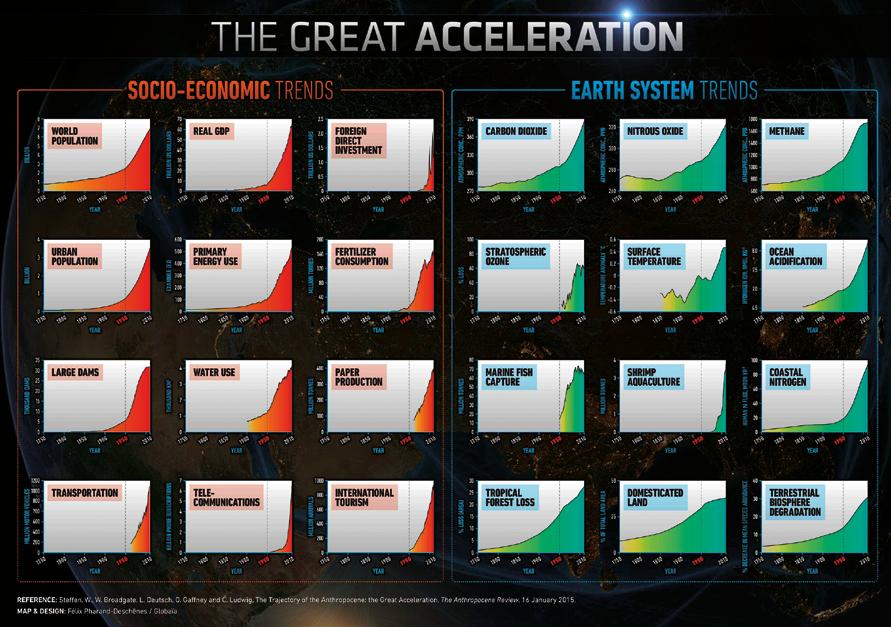
3 minute read
Figure 1: Selected socio-economic and earth system trends since 1750 (Industrial Revolution
from Transdisciplinary Learning for Sustainable Development: Experience in Course and Curriculum Design
1 How Can Science and Education Help Shape Sustainable Development?
1.1 The Anthropocene and the Great Acceleration
Since the Industrial Revolution, humans have become the main shapers of our earth’s ecosystem. The 1950s saw the start of a great acceleration in many socio-economic and earth system trends (Figure 1), prompting calls to coin the current geological era the “Anthropocene”. Human activity frequently results in complex changes that proceed rapidly (temporal aspect) and spread globally (spatial aspect). Changes may have negative and/or positive effects that vary over time and create both winners and losers. The globalized economy is a major driver of problematic or unsustainable development with detrimental effects, such as global warming, pollution, environmental pollution, biodiversity loss, food waste, armed conflicts, and flows of refugees.
Figure 1: Selected socio-economic and earth system trends since 1750 (Industrial Revolution), with a great acceleration since the 1950s (Source: Steffen et al. 2015)
The risks of globalization were impressively laid bare by the COVID-19 pandemic, which, within a very short time, significantly disrupted all aspects of life as we knew it.
In the Anthropocene, humans became the most significant impact factor on the earth’s ecosystem. Since the 1950s, the Anthropocene is characterized by a great acceleration of both global ecological and socio-economic trends. Our ability to do seems to have outstripped our ability to understand what we are doing!
Would you please brake hard? There’s a truck on the road …
Truck? Brake? What a waste of energy ….
Cartoon 1: The Anthropocene – the great acceleration (Illustration: K Herweg)

Current development trends in the Anthropocene seem to be increasing rather than reducing existing global socio-economic disparities, a spatial aspect that is revealed by combining two indicators of global unsustainable development (Figure 2). The “Ecological Footprint” represents natural resource and energy use. It is expressed as the area (in global hectares per year) one person needs to maintain their current lifestyle and living standards in the long run, including the area for production of food, clothing, energy, waste disposal, carbon sequestration, etc. (Global Footprint Network 2003–2021). The “Human Development Index (HDI)” is a national human welfare indicator, representing the socio-economic basis for development. It includes gross domestic product, life expectancy, and probable duration of education per person (UNDP 2021).
About 20% of the world population – mostly industrialized countries in Europe, North America, and the Middle East – currently consume about 80% of the earth’s natural resources. This means that only a change in energy consumption patterns in those countries will lead to a significant reduction in global natural resource and energy use. Only such a change will help to maintain ecosystem services for future generations. At the same time, the socio-economic basis of many people is insufficient and inhumane, particularly – but not only – in developing countries, among them almost all African countries. Such disparities contradict the UN demand for global equity and justice; they are also at the root of destabilizing processes such as armed conflicts, migration, and flows of refugees.
Today, human activities commonly result in complex changes, i.e. changes that affect all three sustainability dimensions (environment, society, and economy). Changes are often rapid and spread globally, exacerbating existing socio-economic disparities. Changes may have negative and/or positive effects that may vary over time, creating both winners and losers. The global disparities in wealth and natural resource use clearly point the way: reduce energy and resource waste in the industrial countries; improve the socio-economic basis in the developing countries.







